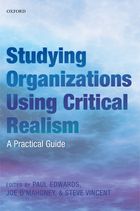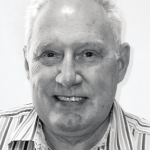Paul Edwards, Joe O’Mahoney and Steve Vincent
If you go to the philosophy or social theory section in any decent public or university library you will find voluminous and, we think, rather interesting tomes outlining realist philosophy. In our opinion, these works provide the most plausible approach to understanding the things that go on in the world and how its many parts are interrelated. One of the commitments of this approach is that the forces that cause things happen do not have to be doing anything to have an effect. Take the example of a filmless speed-camera, which routinely slows down the traffic despite the fact it is practically useless for the purposes of enforcing a speed limit. The actual causes of events can be difficult to know and this creates all sorts of problems for researchers. We were left wondering how to develop research methodologies that scratch beneath the surface and seek out those invisible things that actually matter. The philosophy and theory books offer little guide as to how to do it. We thus started to identify social researchers who used critical realism to inform their work and asked them how a commitment to critical realism affected what they did in practice. Our book “Studying Organisations Using Critical Realism” is the outcome of these endeavours.
Our contributors to are suspicious of positivist social scientists, who claim to be “proper” scientists. Positivists tend to explain social phenomena by making generalisations from statistical correlations between observed events. In these accounts all that matters is that which can be measured, which rather fails to scratch beneath the surface – the existence of a speed camera and its correlation with reduced speed offers an explanation in itself. On our opinion, this seems rather thin. Our contributors also feel that social constructivists, who reduce social complexity to the discourses we use to understand it, rather throw the baby out with the bathwater. Whilst the subjective schemas of the driver and their identification the speed camera matter, other things, such as the very real consequences of being caught speeding, tend to fall away from view, despite the fact that these things must be implicated in an explanation. Critical realism encourages the researcher to dig deeper, to reveal the abilities of the driver (their memory, their [in]ability to perceive whether the speed camera has film in it or their imagining of the consequences of their actions). Critical realists look beyond the immediate event, to a world in which traffic enforcement officers have power to sanction behaviour and people know this to be the case. It is only by taking account of this broader range of matters that we can develop a better explanation of why the driver put her foot on the brake as she approached the (redundant) speed camera.
The problem that realists have with positivist and social constructionist approaches is not just that they lack explanatory depth, but that their explanations bear absolutely no relation to the lived experiences of individuals. One hopes that positivists might accept a declaration of love without reaching for the measuring tape and scales, or that constructionists might accept advice about vaccination requirements before they jet off on an exotic holiday. Alternative scenarios in day-to-day life are obviously ludicrous, but for some reason the assumptions seen to carry weight in academia.
In our view, as a consequence of its richer approach to understanding human activities critical realism is the least-worst ontology available and, as such, it should be embraced. We say least worst because, as a result of a commitment to this ontology, we also recognise that our empirical observations are often only flotsam generated by underlying processes which are often invisible; that things can be real at different, related levels; and that many things have properties, powers and potentials that are not presently identifiable. The point is that these commitments all make the process of doing social research quite difficult (indeed, in our view this is why many researchers reach for the relative security of positivist or social constructionist comfort-blankets, or retreat into abstract theory).
However, whilst these commitments make social research difficult we do not see these challenges as insurmountable. Furthermore, the answers that realists develop are, at a basic level, more similar to the ones the “woman on the street” might recognise. If we are to understand, for example, entrepreneurial behaviour, it is useful but not sufficient to show that they are drawing on discourses such as those of “the enterprise culture”. It may also be useful to know that entrepreneurial behaviour is correlated with certain social factors, such as having a parent who was also an entrepreneur. But these explanations are very partial indeed. A realist approach would not only examine the discursive resources that people draw on when they make decisions or their socio-economic characteristics, but also the context within which they reside, the resources they have access to, their attitudes towards their activities and the consequences of their activities for the things that happen around them. In short, critical realist social researchers embrace a rich view of the social agent, who is affected by the things in the surrounding context in knowable ways, whilst they are also engaged in projects that are designed to satisfy their own wants and desires. Who could disagree with this?
The research methodologies outlined in our book unpick, in different ways, aspects of this rich perspective on social agency. We chose to focus primarily on the world of work and organizations, in part because of their centrality to social life and in part to provide a common focus for the individual chapters. These chapters embrace core research methods such as interviews, the case study, discourse analysis, ethnography, action research, comparative methods, and quantitative modelling. Each chapter explains main lines of debate, outlines a realist approach, discusses how it makes a difference, and offers detailed illustration of how the approach works in practice. Realism comes, however, in several varieties. Each chapter explains the specific use made of it, and the challenges faced. We also included some scholars with a broad commitment to realist explanation and others who embrace critical realism – the central difference being that the latter also see their explanations as having reasonably direct implications for social action, whereas other realists prefer a distinction between analysis and prescription. We also included a chapter that reflects on the wider challenges facing realism, critical realism, and later developments known as dialectical realism.
The end result is a compendium that will prove useful for any social researcher who believes there is more to the world than words and numbers, and who then wishes to engage in concrete research. It will also help the many adherents of realism to grasp what the approach can do empirically, but also to see some of the challenges involved.


